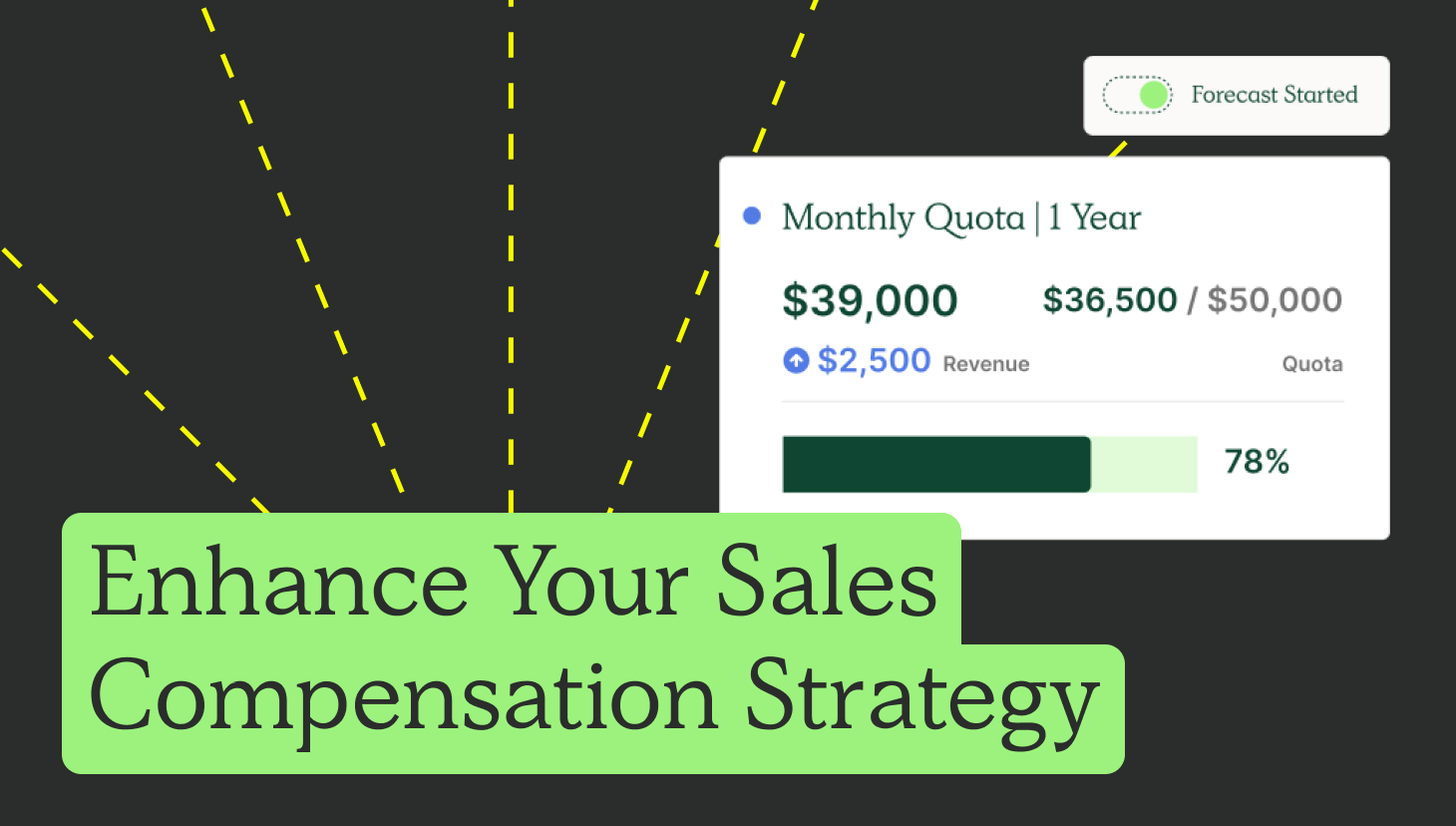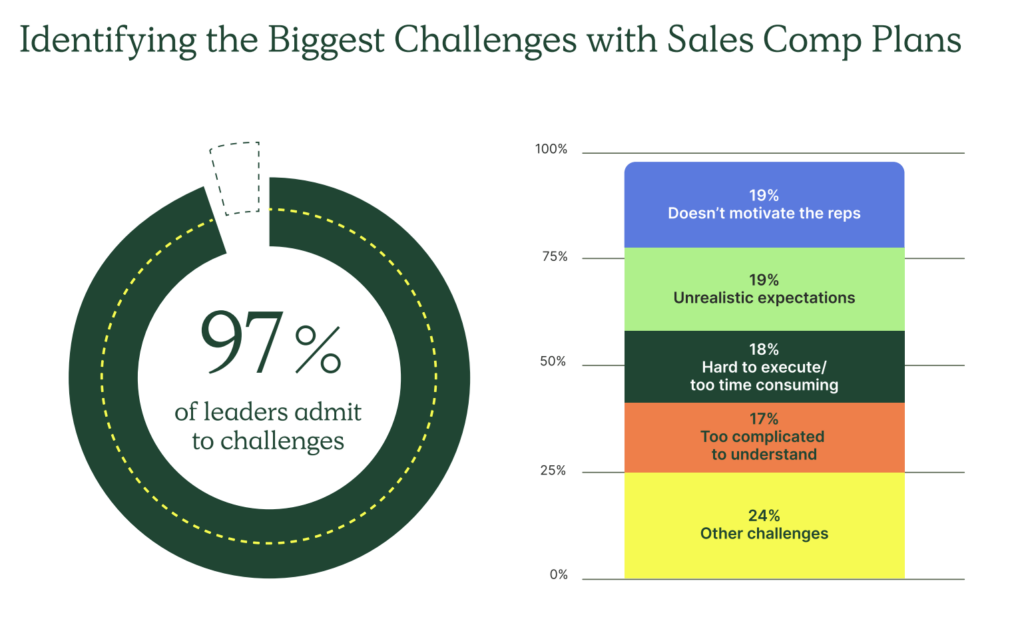A solid sales compensation strategy will drive revenue and your most important business metrics. It motivates your reps’ selling behaviors, receives positive feedback from your go-to-market teams, and builds loyalty between leadership and your front line.
Sounds nice, right?
Wouldn’t you know that 97% of leaders admitted to experiencing challenges with their sales compensation plans in our most recent compensation trends report?
That’s because designing compensation structures that align teams (looking at you, Finance, Sales, and RevOps), drive North Star metrics, motivate reps, and are fair and logical is much easier said than done.
Let us help.
Our team, namely our VP of RevOps Ryan Milligan and Head of Partnerships Graham Collins, conduct compensation consultation calls to review your compensation structure and offer feedback and suggestions.
Both kickoff calls include the same seven questions to gauge the health of your plans. Fortunately, we’ve automated this to give you instant feedback on your plans.

Evaluate the Health of Your AE Comp Plans
Answer 7 questions to assess if your new business compensation plan strategy is healthy and balanced.
Check My Comp PlanHowever, if you’d like to skip that step and read five ways to immediately enhance your compensation strategy for sales growth, see below.
Align Your Compensation Plan to Business Objectives
First, you need to focus on alignment.
39% of RevOps leaders said their comp plans fail to align with their key performance indicators, according to our report. This step is crucial to the success of your compensation plan. Aligning your compensation plan with company goals and sales activities ensures reps are rewarded for the behaviors that drive success.
One way to do this is to wait to develop your incentive plans until your team has solidified your KPIs for the year. This is especially prevalent for those looking to address their startup company sales compensation strategy. Wait for board approval.
Then, build incentive components that directly correspond to those objectives. For instance, if your focus is growing retention and increasing closed/won rates, motivate your commission-earning reps to close and retain accounts that fit your ideal customer profile.

Test Your Compensation Plan
Next, you should test different structures through pilot programs or simulations to help identify potential issues and unintended consequences before full implementation. You can do this by:
- Applying last year’s numbers to your new proposed plan. (This is considered high-level testing)
- Scenario test according to next year’s revenue assumptions. (Include SPIFs and any overlaps with bonuses and accelerators).
- Identify the highest possible commission payout a rep can achieve on a deal, considering all applicable commission rules.
- When testing, look at the average annual commission earnings across the sales team.
- Test the impact of individual factors like quota-to-OTE ratio, commission rates, and multipliers in isolated settings.
Comp Plan Scenario Modeling & Testing
Run compensation plan scenario modeling and test Draft Plans in QuotaPath.
Learn More
Measure Performance
Once your plan is up and running, you must monitor its performance. You can do this by regularly tracking critical metrics to see how your compensation plan impacts sales results, rep behavior, cost, etc.
We recommend the following:
- Attainment over time to identify seasonal trends and rep selling consistency
- Revenue growth rate to evaluate the impact of sales commissions on revenue increases
- Earnings by comp plan component to learn which part of your comp plans sellers are earning the most from
- Commission expense ratio to compare compensation expenses to gross profit margin
- Commission payout ratio to track the percentage of revenue used to payout commissions
- Effective rates to see if you’re underpaying or overpaying everyone who earns a commission per deal
- Average deal size to measure the average value of sales transactions against the size of deals reps sell most of
Recommended Reading: How to Measure Sales Commission Effectiveness
Accept That You’ll Need to Adjust It
Now that you know which metrics to pay attention to, you can adapt your plan according to those data points, anecdotal rep feedback, and what the market conditions call for.
Should you need to make adjustments, remember that you can test future changes by implementing a SPIFF. This lets you see how a comp component influences selling behavior before solidifying it within your comp plan.
For instance, if you’re contemplating multi-year contract accelerators, test a higher commission rate for a month or quarter as a SPIF for contracts lasting 2+ years.
Recommended Reading: Do SPIFs Work? Why and When to Use SPIFs
Customize to Role/Territory/Product/Team
Lastly, do not, under any circumstances, copy and paste a compensation plan across companies, teams, and products.
A one-size-fits-all approach rarely works.
Consider tailoring elements of the plan to account for specific roles, territories with varying sales cycles, or unique team dynamics. Your most senior reps should not be on the same comp plan as your junior account executives. While you may apply the same commission rates and SPIFs, your senior reps should have different quotas and OTEs. Likewise, reps entering a new territory should be on plans that mirror a startup’s first compensation plan.
Recommended Reading: How to Build a Comp Plan For a New Territory or Product
Additional Considerations
These five practices should put you in a good position to increase the performance and value of your compensation strategy.
Some additional things to consider:
- Simplicity and Transparency: A complex compensation plan can be confusing and demotivating. Strive for clarity and easy comprehension for your sales team.
- Internal Controls and Audits: Maintain a system of checks and balances to ensure accuracy and prevent errors or potential abuse.
- Communication is Key: Communicate the rationale behind your compensation plan and any changes made. Explain the “whys” and provide ongoing support to reps.
- Competitive Benchmarking: Research industry standards and competitor compensation structures to stay competitive in attracting and retaining top talent.
By incorporating these elements, you can create a sales compensation strategy that effectively motivates your team, drives desired sales behaviors, and ultimately fuels business growth.
Try QuotaPath for free
Try the most collaborative solution to manage, track and payout variable compensation. Calculate commissions and pay your team accurately, and on time.
Start TrialAbout QuotaPath
Need additional assistance with your compensation structures? QuotaPath partners with companies to design plans to motivate selling behaviors that align with their business goals. From free compensation plan consultations to in-app plan modeling and analytics, we’re here to help. Schedule a time with our team to learn more.




